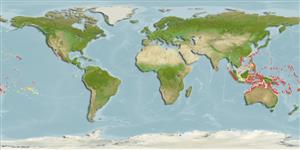Preferred temperature (Ref.
123201): 25.6 - 29.3, mean 28.5 °C (based on 1837 cells).
Phylogenetic diversity index (Ref.
82804): PD
50 = 0.5000 [Uniqueness, from 0.5 = low to 2.0 = high].
Bayesian length-weight: a=0.00562 (0.00258 - 0.01228), b=3.06 (2.87 - 3.25), in cm total length, based on LWR estimates for this (Sub)family-body shape (Ref.
93245).
Trophic level (Ref.
69278): 3.5 ±0.41 se; based on food items.
Widerstandsfähigkeit (Ref.
120179): hoch, Verdopplung der Population dauert weniger als 15 Monate. (Preliminary K or Fecundity.).
Fishing Vulnerability (Ref.
59153): Low vulnerability (10 of 100).
Nutrients (Ref.
124155): Calcium = 126 [67, 200] mg/100g; Iron = 0.726 [0.440, 1.189] mg/100g; Protein = 18.4 [17.4, 19.5] %; Omega3 = 0.104 [0.060, 0.178] g/100g; Selenium = 25.1 [12.1, 50.0] μg/100g; VitaminA = 142 [47, 405] μg/100g; Zinc = 1.81 [1.21, 2.54] mg/100g (wet weight);
